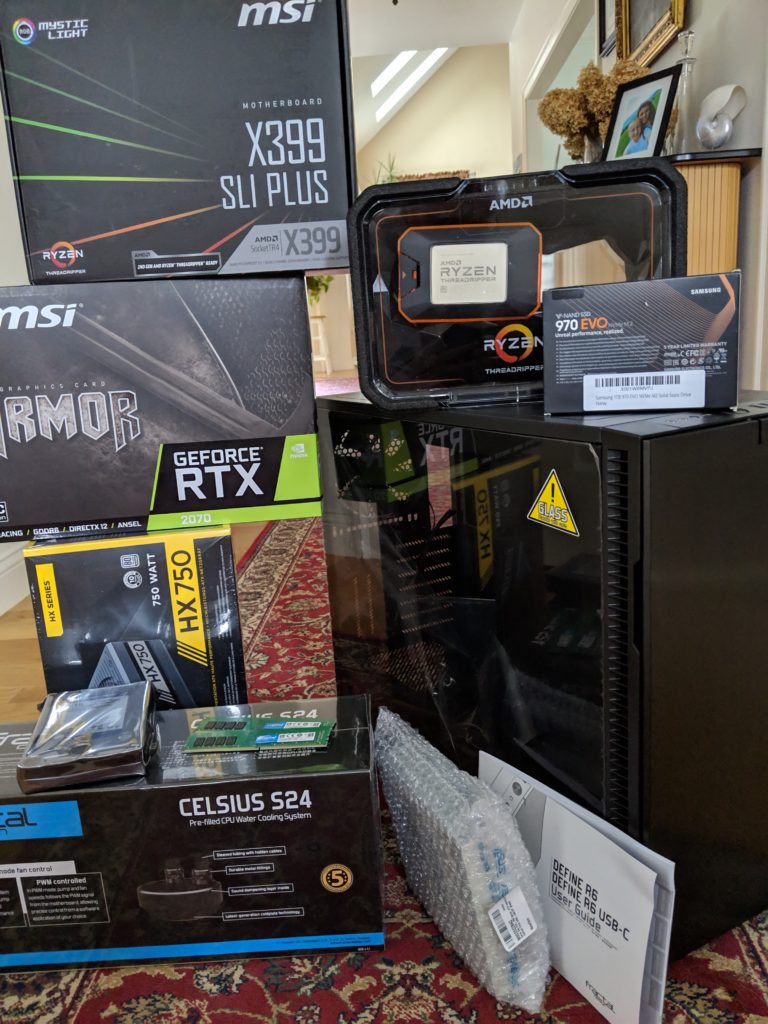It has been almost 4 years since my last computer build, and it was time to hand down the Core I7 from 2015 to my son. As always, I did not want to start from scratch with putting matching components together. I started with a build recommendation from the German C’t Magazine. Luckily, just in time for this project, the January 9 issue contained an article with several options. I picked the top end configuration – a 16 core Threadripper Workstation build with water cooling.
I kept with the original part list except for the DRAM and the CPU cooler.
I skipped the optional ECC modules but used 2×16 GB modules instead of 4×8 GB. The recommended Enermax cooler had mixed reviews on NewEgg and Amazon. I went with a Fractal Design Celsium S24 instead – also listed on the AMD site (and recommended by a friend).
| Samsung 1TB 970 EVO NVMe M2 Solid State Drive | SSD | $279.99 |
| 2 of Crucial 16GB Single DDR4 2666 MT/s – CT16G4DFD8266 | RAM | $109.00 |
| CORSAIR HX Series, HX750, 750 Watt Power Supply | PS | $128.99 |
| WD Blue 4TB PC Hard Drive SATA 6 Gb/s, 64 MB Cache, 3.5″ – WD40EZRZ | HD | $84.99 |
| AMD Ryzen Threadripper 2950X Processor (YD295XA8AFWOF) | CPU | $879.99 |
| Fractal Design Cooler FD-WCU-CELSIUS-S24-BK | COOLER | $135.69 |
| MSI X399 SLI Plus ATX Motherboard | MOBO | $345.00 |
| Asus 24x DVD-RW Serial-ATA Internal OEM Optical Drive DRW-24B1ST Black | DVD | $19.50 |
| MSI GeForce RTX 2070 8GB GDRR6 256-bit HDMI/DP/USB | GRAPHICS | $539.99 |
| Fractal Design FD-CA-DEF-R6C-GY-TGL Computer Case Define R6 USB-C | CASE | $162.61 |
| Sales Tax | – | $143.54 |
| Total | – | $2,829.29 |
Table 1 – Part list and expenditures
This is a hefty price tag for a custom build. I don’t do high-performance computing, and the occasional video editing does not require this kind of hardware. But I wanted this configuration anyway.
I hate to order everything from the monopoly, but after comparing prices with other online vendors, ordering from Amazon turned out to be several hundred dollars cheaper (even before shipping and taxes). And I was able to order via Amazon Smile and donate ~$50 to my favorite charity that way. Call me weak.

There is not much to say about the build process itself. This is all documented elsewhere. There were a few things that took longer than they should, like installing the water cooler fan unit along the top of the case (because the screw heads obstructed the case cover). and with the power supply cable routing because once the power supply was installed, access was difficult, and I had to uninstall it several times for adding additional cables for the graphics card and DVD drive. I did not use additional thermal paste, only what was pre-applied on the cooler.
To my surprise, when I powered it up for the first time everything worked right away.
I ended up moving the graphics card up to the topmost slot because I could not see the diagnostic codes on the motherboard’s LED display (the right light that you see shimmering through between the RTX and the power supply channel in the photo below.
Now, the million dollar question: How fast is it?
Funny – I can’t really tell. I don’t do benchmarks. Subjectively speaking, it is pretty responsive. But that’s not a scientific measure.
The good old Windows Experience Index is still available. This machine is of course faster than anything I have ever owned (or seen), but in the absence of comparative data with other high-end machines, this score is rather meaning less to me. But 9.2 seems to be a good place to be in. It does not seem that the number of logical cores contributes to the index. At all.
The most noteworthy thing about this machine is that it is so quiet. It is much more quiet than my last computer. I can barely hear it when it is on. Only under load the fans become audible, but overall this machine is the most quiet computer I have owned in over 30 years, and this includes my current laptop. My Lenovo P71 with “everything” gets pretty howly at times (is that even a word?).
The other thing that surprised me is the performance of the Samsung EVO M.2 SSD. It is about as wide as a dime and reads data at 1.5GB/s.
The good old WD Blue is as slow as ever, so no surprises there. Standard fare, but all that is needed for a document repository.
tbd: power consumption, CPU temp under load